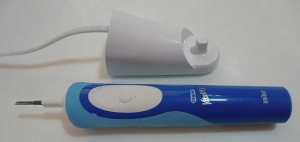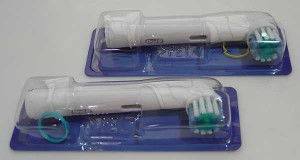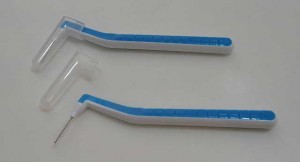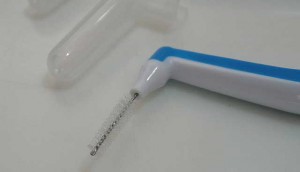7 habits for healthy gums
Gum disease often goes unnoticed until teeth start to loosen or move position. These 7 tips will help you have healthy gums…and keep your own teeth for your lifetime.
1. invest in an electric-powered toothbrush…
An electric-powered toothbrush is much more effective at removing sticky plaque and food debris than an ordinary toothbrush.
Various companies make them…Oral B and Philips to name just two.
Here’s a photo of our entry-model Oral B Vitality…
The brush unit normally sits on the base unit, which needs to be plugged in to keep the brush charged. Doesn’t have to be in the bathroom…plug it in to any socket.
Choose a model with a small brush-head, because it’s much easier to reach all the nooks and crannies in your mouth…like behind your last top tooth each side.
These are the Oral B brushes. Each comes with a different coloured clip-on ring to identify your own brush, so the base unit can be shared…
Before you decide which make of electric toothbrush to buy, check out the prices and availability of the replacement brushes in your local shops. Some makes you may find difficult to get.
don’t scrub…
When you’re using your e-brush, guide it around each tooth, letting the brush itself do the work. There’s no need to scrub with it.
Guide it not only over the tooth surfaces, but also around the gum margins, cleaning the gums as well.
Lastly, stick your tongue right out and give it a scrub, too. If you keep your tongue thrusted stiffly out, and scrub it rather than tickle it, you won’t see your breakfast again.
wait awhile before brushing…
Wait 20 minutes or so after a meal before brushing your teeth. This allows minerals that may have been lost from the surfaces of your teeth, to be replenished from your saliva.
Brushing too soon after eating can result in permanent loss of the minerals and wearing away of your tooth enamel.
2. inter-dental areas…
Even the very best e-toothbrush will not reach between your teeth. And if you don’t clean those areas, you’ll still end up with gum disease, no matter how enthusiastically you’ve used your electric brush.
Flossing is good, but not enough on its own. The strand will remove food remnants from tooth surfaces, only where it touches. If a tooth has a natural small depression in its surface…and many do…the floss will skate over the top of the dip, without cleaning in the hollow.
Floss reaches about 2 mm under the gum edge, which means debris deeper than that remains untouched.
inter-dental brush…
In addition to floss, use a small inter-dental brush.
These look like a miniature bottle brush on the end of a handle. They come in various sizes, so in theory, you can choose one that fits the natural gaps between your teeth. Start with the thinnest one you can find…about 0.5-0.8 mm.
It’s best to look in the mirror while using it, so no corners are missed…and gums aren’t stabbed.
Poking around blindly with sharp toothpicks, or scrubbing too hard with the “bottle brush”, can push the pointed bits of gum between teeth down, creating the appearance of little gaps between your teeth. Don’t let that stop you cleaning, though…gum disease is far worse! Just be gentle, and carefully and effectively clean between your teeth.
3. kill the germs…
Ordinary bicarbonate of soda (aka baking soda) from your local supermarket is a very effective killer of the germs lurking around teeth and under gums that cause gum disease.
Mix it into a paste with water, so it’s not abrasive. I mix it in the palm of my cupped hand, and dab my e-brush in the mixture there. Use it on your e-toothbrush, and your inter-dental brush, just as you would ordinary toothpaste.
After you’ve finished brushing, rinse thoroughly with warm water, trying to swish the water between your teeth to loosen debris.
Personally, I avoid alcohol-based mouth-washes, as I believe they kill some bacteria and not others, thereby disrupting the normal healthy balance of bacteria in the mouth and throat.
4. irrigate…
The germs that cause gum disease live not only in the sticky film we all know as plaque. They also cling to the inside surfaces of gum pockets, and float about in the fluids within the gum crevices and pockets.
This is especially so between teeth, where the gum pockets are very difficult to reach and clean properly, and often fester away, undisturbed.
Even with enthusiastic use of an e-brush, floss, and an inter-dental brush, you’ll probably not remove all the bacteria from the depths of a gum pocket, simply because you cannot reach all the way down to the bottom of the pocket.
An irrigating device can reach those neglected areas, though. The Germans call it a “Munddusche”, which literally means “mouth shower”, and it’s a far better description of what the machine actually does.
It’s basically a small tank to hold water, a pump to pulse the water through a small pipe and out through a tip you can guide around your mouth.
The pulse of water kind of pressure-hoses the plaque and germs off teeth and out of gum pockets, and is especially useful for cleaning debris out of the gaps between your teeth.
Spray from the inside-outwards, too, not just outside-inwards.
You’ll be quite amazed what comes out of your mouth into the sink, even though you’ve just finished cleaning your teeth!
Waterpik is probably the best-known make. The company has been at it a long time. Other companies make oral irrigation devices, too, as you’ll see if you use Google search or nip along to your local shopping centre.
For an extra germ-killing boost, dissolve a little bicarbonate of soda in the tank instead of using just plain warm water.
5. take supplements…
Nowadays, you need to take supplements to fill everyday nutritional gaps…and they’re needed for healthy gums, too.
Here’s why…
The basic “skeleton” of bone and gum tissue is collagen. Without collagen the bone and gum around teeth cannot be formed properly, and any pockets you may have won’t heal well.
One of the important building blocks of a collagen molecule is vitamin C.
As everyone knows, vitamin C is water soluble, and is not stored in the body like fat-soluble vitamins are. So, in order to maintain a healthy collagen production, vitamin C needs to be available every day.
Centuries ago, sailors survived for months at sea on a diet of dry biscuits and salted meat, neither of which contains vitamin C. They all had horrible skins and toothless grins as a result of scurvy, the name of the medical condition caused by chronic lack of vitamin C (and therefore an inability to make collagen).
Thanks to an enlightened ship’s surgeon, who gave them limes to eat, British sailors no longer suffered from scurvy…and got the nickname “Limeys” in the process.
As a result of the monoculture way fruits and vegetables are farmed nowadays, picked very early, and shipped around the world in giant cool-boxes, you may not get as much vitamin C in your citrus as you expect.
Why take the chance? A daily vitamin C supplement will ensure your gums have got it when they need it.
Order GNLD Vitamin C sustained release safely online, here.
6. choose power-foods…
Antioxidants help strengthen the immune system, which is the body’s main healing mechanism.
A daily supply of water-soluble flavonoid antioxidants, and fat-soluble carotenoid antioxidants, will work hand-in-hand with vitamin C to help you maintain healthy gums.
You can get antioxidants by eating colourful whole foods every day…
- red, yellow, and purple berries
- red, yellow, and orange fruits like papaya, cling peaches, water melon, citrus, plums
- green leafy vegetables like spinach, cabbage, kale, lettuce
- coloured vegetables like pumpkin, tomato, paprikas, beetroot, orange, and purple sweet potato
Spices are a good way to get antioxidants, too. Garlic, ginger, turmeric, chilli, rosemary, thyme, oregano, parsley, to name just a few.
These downloadable files I got from the United States Department of Agriculture website have more extensive lists of antioxidant-rich foods: Carotenoids in Foods (.pdf file 166KB) and Flavonoids in Foods (.pdf 952 KB).
There’s quite a lot of science in the pdf’s, which you can scroll past if you want, and go to the actual lists of foods.
Look for foods with high numbers in the first column of numbers to the right of the food names. The column is headed “Mean”, which is the average amount of various antioxidants found in different samples of the particular food.
Interestingly, you’ll also see which foods have hardly any antioxidants in them at all.
To paraphrase Donald Trump’s famous phrase: if you’re going to be eating, you might as well eat antioxidants.
(Donald Trump actually said: “If you’re going to be thinking, you might as well think big!”)
If not many antioxidant-rich foods are on your plate every day, consider taking a carotenoid supplement like GNLD’s Carotenoid Complex…and a flavonoid supplement like GNLD’s Flavonoid Complex…or all-in-one PhytoDefence.
7. have your pockets measured regularly…
It’s not possible for you…or your dentist…to see how deep the crevices around your teeth are, by staring at them in a mirror.
Ask your dentist to measure the depth of your gum pockets when you go for your regular check-up. It’s very easy to do…and painless.
A thin, blunt probe with graduated markings on the side is slid gently between gum and tooth at various places around each tooth, and the depth of the crevice at the different points noted in your patient file.
In this simple way, your dentist can find areas where the gum crevice is deeper than the normal 1-2 mm. Then, if you pay particular attention to those deeper areas during your cleaning routine, you’ll be able to reverse the disease process before it really gets a hold.
Prevention is far cheaper, and much more comfortable than the cure, so don’t wait until your gums have lost their attachments to your teeth…get ‘em measured at your next visit to your dentist, and have it done regularly thereafter so you can monitor how well you’re cleaning your teeth and gums.






what cuases the teeth to be removed at the end,after heavy pain,which measures can be used to avoid such problems encoutered by millions of people?
Hi Harrison.
Forgive the frankness: the short answer to your question is… neglect!
If you look after your teeth by cleaning them (and the gums holding them in place) thoroughly every day, choose foods as near to their natural state as possible (to get the most nutrients from what you eat), then you’ll have very few dental problems.